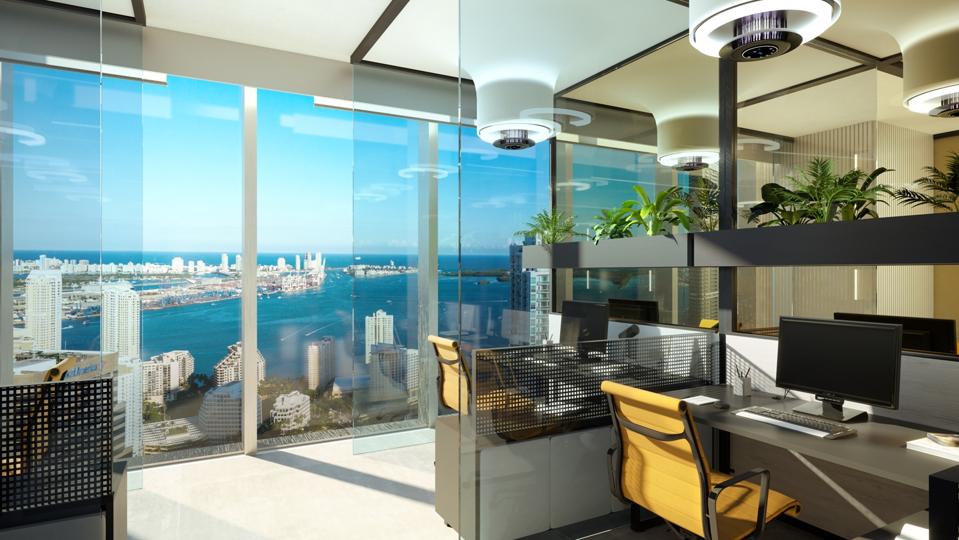
An office build-out at Miami’s new 830 Brickell office tower features transparent glass panels … [+]
Iosa Ghini Associati
How can office buildings be prepped for a post-COVID return by staff? Answers are almost as myriad as the developers, architects, interior designers and software creators focused on the issue. From complex indoor-outdoor air exchange systems to toe-operated elevators, the list of innovative solutions seemingly grows longer by the day.
OKO Group‘s 830 Brickell, the first new Class A office tower to deliver in downtown Miami in more than a decade, is slated for completion in 2022. With the onset of the pandemic, the developer got to work on ideas designed to ready the tower for the post-COVID world.
Designed by Adrian Smith + Gordon Gill, with interiors by Ghini Associati, 830 Brickell will offer touchless technology and air purification systems, UV lights and contactless exit and entry. Moreover, the tower is a blank canvas that will allow corporate tenants over the next two years the design flexibility to pivot with changes in pandemic-era safety protocols.
“The flexibility afforded by first-generation office space is everything in the eyes of tenants planning for the long term,” says Vanessa Grout, CEO of Miami-based OKO Real Estate.
“Based on what we are hearing from tenants, companies are looking beyond near-term health concerns and envisioning their personnel and space needs 10 to 15 years in the future. Companies want the ability to design their office from scratch, giving them the ability to incorporate the latest technologies and health features within their space.”
Elsewhere in Miami, Creative HQ — a development featuring 127 flexible office condos extending in size from 431 to 2,499 square feet – is also preparing for the future. Its developer is adding high-efficiency air conditioning and air filtration units, separate elevators between office and residential spaces, operable open-air windows and keyless entry capabilities allowing owners and guests building access without surface contact.
The new 12-story, 90,000-square-foot office and retail building Fulton East in Chicago’s West Loop submarket will offer the latest must-have amenity: the first new-construction installation of MAD Elevator Inc.’s Toe-To-Go elevator system, incorporating foot-activated call buttons. And in San Jose, the 20-story, 781,000-square foot Almaden Boulevard Tower when completed will include coronavirus-era features and amenities like interconnecting staircases within tenants’ spaces, as well as the inclusion of outdoor areas to provide access to fresh air. A marriage of centralized and decentralized building systems within the tower has been designed to permit flexible ventilation and new air filtration.
Hubs, spokes
Another COVID-era trend is a growing emphasis on the hub-and-spoke office platform, in which a central hub office is used as the company flagship for meetings and collaboration, but smaller spoke offices nearer employees’ homes let teams work together and simultaneously garner greater work-life balance. The hub-and-spoke model is nothing new, but the pandemic has grown the enthusiasm with which employers are embracing it, says Bryan Murphy, CEO of Breather, a New York City company providing flexible, private office space.
“We will continue to see the hub-and-spoke model evolve to provide businesses with different types of distraction-free space, from short term off-site spaces to bring teams together, to drop-in spaces in different geographies where employees can have productive space to work closer to their homes,” Murphy says.
Spokes will feature a mix of desk space and conference rooms, offer lots of open space and will function best for small, specialized teams in sales, human resources, accounting and finance or marketing, Murphy believes. The hub, on the other hand, will increasingly be seen as the company’s cultural center, but no longer the base where all staff appears every workday.
Cleaning protocols
Part and parcel of the COVID-19 era is the need for repeated and exceptionally thorough cleaning and sanitizing of offices. As necessary as is this protocol, the harsh chemicals used in sanitizing pose the problem of damaging some of the design elements in these spaces. Among those elements are wooden doors that deliver warmth and character to office settings.
Door product manufacturer and distributor ASSA ABLOY has addressed this issue by creating smooth wood-grain stainable steel door products from Ceco Door and Curries. The doors are designed to stand up to rigorous cleaning cycles, imbuing warmth and elegance while maintaining the durability that frequent cleaning will dictate during and after the pandemic.
Finally, property managers must more fully manage traffic of visitors in and out of their office buildings during the pandemic. Enter cloud-based access control and physical security platform provider Brivo, which recently unveiled Brivo Visitor, a kiosk-based visitor management solution for commercial properties.
Among other benefits, Brivo Visitor gives commercial buildings the ability to ask questions related to COVID-19, and capture data that could be needed later for contact tracing in the event a visitor tests positive for the virus.
